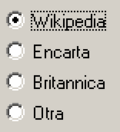An HTML element is a type of HTML (HyperText Markup Language) document component, one of several types of HTML nodes (there are also text nodes, comment...
114 KB (12,895 words) - 09:30, 14 November 2024
and may include sub-element tags. Browsers do not display the HTML tags but use them to interpret the content of the page. HTML can embed programs written...
83 KB (9,529 words) - 12:43, 5 November 2024
effects). Example setting element size and drawing surface size to different values: <!DOCTYPE html> <html> <head> <title>Canvas element size: 600 x 300, Canvas...
14 KB (1,486 words) - 14:26, 10 December 2023
of an HTML element.HTML attributes are a modifier of a HTML element type. An attribute either modifies the default functionality of an element type or...
38 KB (1,826 words) - 06:28, 14 November 2024
A canonical link element is an HTML element that helps webmasters prevent duplicate content issues in search engine optimization by specifying the "canonical"...
8 KB (837 words) - 13:46, 4 July 2024
Div and span (redirect from Span element in HTML)
authors. Where no existing HTML element is applicable, <span> and <div> can valuably represent parts of a document so that HTML attributes such as class...
13 KB (1,571 words) - 01:50, 16 July 2024
display = "block"; textElement.innerHTML = "Hide paragraph"; } else { displayElement.style.display = "none"; textElement.innerHTML = "Show paragraph"; }...
11 KB (1,435 words) - 15:54, 6 September 2024
Microdata is a WHATWG HTML specification used to nest metadata within existing content on web pages. Search engines, web crawlers, and browsers can extract...
12 KB (1,293 words) - 13:14, 6 August 2024
element has two uses: either to emulate the use of an HTTP response header field, or to embed additional metadata within the HTML document. With HTML...
23 KB (2,886 words) - 14:27, 7 June 2024
Document Object Model (redirect from HTML DOM)
standard. In HTML DOM (Document Object Model), every element is a node: A document is a document node. All HTML elements are element nodes. All HTML attributes...
19 KB (2,181 words) - 19:34, 19 October 2024
CSS (redirect from Pseudo-element)
"CSS class", although sometimes used, is a misnomer, as element classes—specified with the HTML class attribute—is a markup feature that is distinct from...
81 KB (8,032 words) - 13:34, 15 November 2024
formalise this approach to semantics in HTML. One important restriction of this approach is that such markup based on element inclusion must meet the well-formedness...
11 KB (1,210 words) - 23:36, 26 September 2024
Frame (World Wide Web) (redirect from HTML frame)
delineation. The iframe element is used inline within a normal HTML body, and defines the initial content and name similarly to the frame element. Any text inside...
14 KB (1,786 words) - 06:16, 27 August 2024
HTML video is the only widely supported video playback technology in modern browsers, with the Flash plugin being phased out. The <video> element started...
60 KB (5,265 words) - 09:26, 12 October 2024
An HTML editor is a program used for editing HTML, the markup of a web page. Although the HTML markup in a web page can be controlled with any text editor...
12 KB (1,593 words) - 15:22, 30 October 2024
The marquee tag is a non-standard HTML element which causes text to scroll up, down, left or right automatically. The tag was first introduced in early...
8 KB (999 words) - 20:50, 11 September 2024
The blink element is a non-standard HTML element that indicates to a user agent (generally a web browser) that the page author intends the content of the...
16 KB (1,720 words) - 04:41, 23 October 2024
up Element, element, élément, Elements, elements, or éléments in Wiktionary, the free dictionary. Element or elements may refer to: Chemical element, a...
6 KB (681 words) - 23:40, 6 November 2024
results from a search engine. Forms are enclosed in the HTML <form> element. This HTML element specifies the communication endpoint the data entered into...
16 KB (1,982 words) - 00:37, 9 November 2024
ROOT elements are also called document elements. In HTML, the root element is the <html> element. The World Wide Web Consortium defines not only the specifications...
3 KB (313 words) - 11:57, 6 August 2022
HTML audio is a subject of the HTML specification, incorporating audio input, playback, and synthesis, as well as speech to text, all in the browser....
19 KB (1,581 words) - 18:08, 18 October 2024
Web platform (section HTML)
and may include sub-element tags. Browsers do not display the HTML tags but use them to interpret the content of the page. HTML can embed programs written...
6 KB (914 words) - 20:44, 24 February 2024
Document type declaration (redirect from HTML DOCTYPE)
element in the document. For example, in XHTML, the root element is <html>, being the first element opened (after the doctype declaration) and last closed...
16 KB (1,973 words) - 16:45, 24 March 2024
Radio button (section HTML)
button the only button in the "pushed in" position. In web forms, the HTML element <input type="radio"> is used to display a radio button. Example: <form>...
4 KB (434 words) - 21:00, 20 June 2024
included within the document itself. For HTML it is possible to include this information inside the head element near the top of the document: <meta...
24 KB (2,460 words) - 20:03, 12 October 2024
by using either a whitelist or a blacklist approach. Leaving a safe HTML element off a whitelist is not so serious; it simply means that that feature...
4 KB (405 words) - 10:05, 7 December 2023
in Wiktionary, the free dictionary. IFrame may refer to: iframe, an HTML element I-frame, a type of video frame in video compression "I-Frames", a shorthand...
400 bytes (82 words) - 19:19, 12 February 2024






